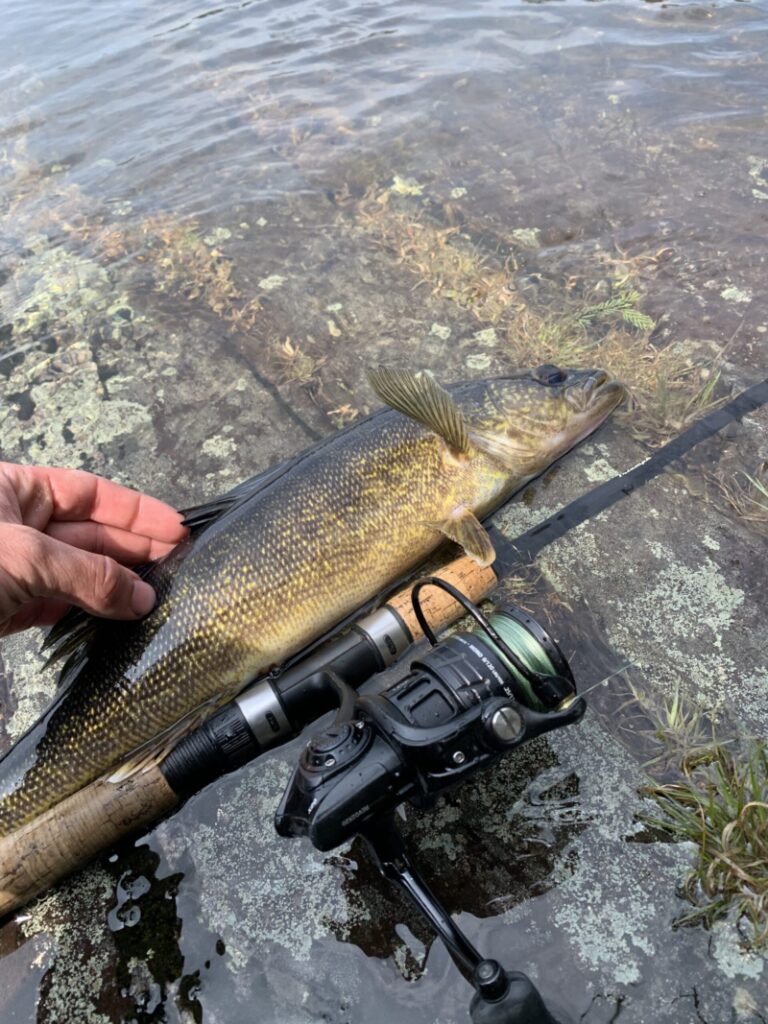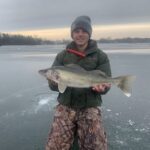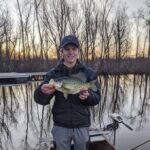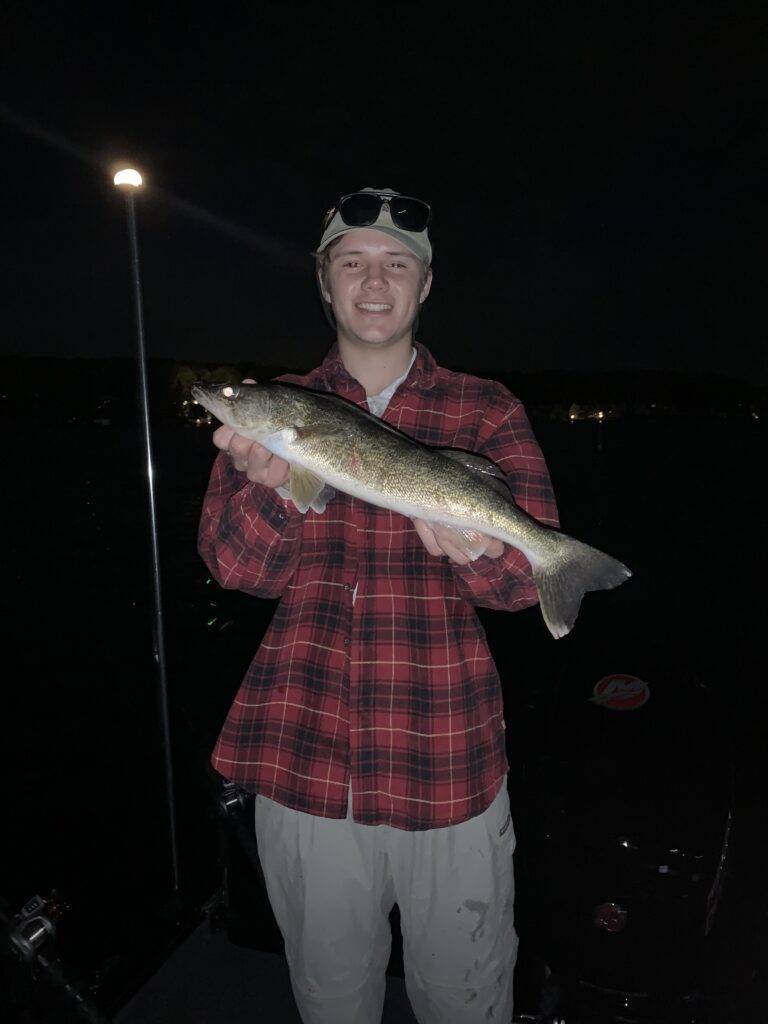Fall Walleye Fishing
Hey there, fellow anglers! As the leaves start to turn and the crisp fall air arrives, walleye fishing ramps up before winter arrives. I love fishing for walleye at all times of the year, but fall has a special place in my heart. If you’ve never fished for walleye in the fall before, this is one of the best times of year to chase trophies. So without further ado, lets uncover the hidden secrets of fall walleye fishing. In this article, we’ll dive into the tactics, techniques, and additional tips that will help you succeed in your next fall walleye fishing outing. Whether you’re a seasoned pro or just starting out, we’ve got you covered.
Table of Contents:
- Fall Walleye Behavior
- Walleye Fishing Gear
- Best Walleye Lures In The Fall
- Fall Walleye Location
- Fall Fishing Techniques
- Fine-Tune Your Approach
- Conservation
As always, fishing education and conservation are our priorities here at The Angler’s Line. Feel free to sign up for our free newsletter to join our community and stay up to date! Lets get started!
Understanding Fall Walleye Behavior
Fall is one of those magical times of year for walleye fishing enthusiasts, and understanding their behavior is key to seeing success during this season. As the water cools down, walleye become more active and start moving to their fall feeding grounds. They tend to follow the schools of baitfish into the shallows, which makes locating them a bit easier.
Migration Patterns
During this time, walleye undertake a migration to shallower water in search of food to bulk up for the upcoming winter. In the summer months, walleye relate to deeper mid-lake spots near the basin of the lake. Come fall, walleye tend to abandon these locations and follow the baitfish into the shallows. In general, areas with points, rocky structures, and weed edges are good starting points when searching for walleye. The main takeaway here is that the fall walleye migration mirrors the fall baitfish migration. Follow the baitfish to find the walleye.
Feeding Habits
In the fall, walleye go on a feeding frenzy to pack on the pounds before the colder months. They feed on a variety of prey in the fall, but baitfish are king for the most part. To mimic their preferred meals, choose fast moving and erratic lures that resemble these baitfish.
Walleye Fishing Gear
To enhance your experience on your next fall walleye fishing outing, you’ll need the right gear. Let’s take a closer look at the essential equipment and tackle choices that will give you an edge.
Rod and Reel Selection
When it comes to the proper spinning rod for walleye, I recommend choosing a medium-light to medium power spinning rod with a fast action tip. As for as length goes, a rod between 6.5′ and 7.5′ is a good starting point for almost all walleye fishing applications. This provides enough sensitivity needed to detect subtle strikes and enough backbone to set the hook and control the fight. Pair your rod with a 2000 of 3000 size walleye spinning reel of your choice that has a smooth and reliable drag system.
Line and Leader Recommendations
For most fall walleye fishing techniques, I am a proponent for using a braided main line with a fluorocarbon leader. Braided line has a thinner line diameter than fluorocarbon, so you can get away with a slightly heavier pound test. For braid, choose between a 10 lb-20 lb test. For fluorocarbon, opt for a line between 6 lb- 12 lb. One exception to this is crankbaits. If you plan on using crankbaits, you are much better off running a monofilament line for the added stretch and forgiveness. Like fluorocarbon, choose monofilament between 6 lb – 12 lb. Keep in mind that fall is one of the best times of year to catch a trophy, so choose your line size accordingly.
Best Walleye Lures in The Fall
When it comes to lures, there’s a wide range of options to choose from. Crankbaits, jigs, and soft plastics are all effective choices for fall walleye fishing.
Covering Water With Crankbaits
Crankbaits are well known among walleye anglers for their effectiveness in the fall months. You can choose to either troll crankbaits or cast crankbaits. Either way, crankbaits allow you to fish quickly and cover lots of water. The crankbait that you choose is highly dependent on the depth you are fishing. Choose a crankbait that runs within a few feet of the bottom without constantly hanging up. In order to maximize catch and release success with crankbaits, use barbless treble hooks or remove the front treble.
Jigs and Live Bait
Fishing with jigs is another great option when it comes to fishing for walleye in the fall. Jigs are probably one of the most versatile lures in your tackle box. Remember that during the fall, walleye are aggressive. Finesse fishing is not the way to go. Choose heavier than normal jigs for the given depth. As far as live bait goes, minnows are my preferred choice in the fall. One little secret I’ll give you is to use larger than average minnows this time of year. Walleye are feeding up for the winter and looking for a big meal a lot of the time.
Soft Plastics
Soft plastics work well throughout most of the year, but fall is one of the best times for plastics. The beauty with plastics is that you can fish them quickly and aggressively, which is key during the fall. Once again, I want the emphasize that this is not finesse fishing with slow retrieves and lightweight jigs. Aggressively snap jig for walleye to trigger bites.
Locating Fall Walleye
To find concentrations of walleye in the fall, you’ll need to focus your efforts in the right areas. Let’s explore some key hotspots where you’re likely to encounter them.

Steep Breaks
Keep an eye out for areas that provide quick and easy access to food. Points, humps, and drop-offs with steep breaks do just that. Walleye often sit off the deep side of these structures and use the steep break as a wall to push baitfish up against and feed. Pay attention to the wind direction, as it can push baitfish towards these areas. Fishing the windward side is always a good place to start.
Structure and Cover
The best pieces of cover in the fall tend to have some sort of structure on them. Rocks, vegetation, and submerged wood are all good things to keep an eye out for. This structure attracts baitfish, which in turn attracts the walleye. Look for transitions, such as weed edges or rock to sand transitions. These areas are natural corridors that walleye love to follow.
Depth
In the fall, walleye tend to move to shallower waters compared to the summer months. Start your search in depths ranging from 5 to 15 feet. With the walleyes moving up shallow, this is a great time of year to fish for walleye from the shore. Deeper water can still come into play however during major weather fronts followed by high barometric pressure. This generally pushes the walleye to slightly deeper water for the time being. Once again, this is why steep breaks with quick access to deep water are great locations to look for fall walleye.

Effective Fall Walleye Fishing Techniques
Now that we’ve covered the basics, let’s dive into some tried-and-true techniques for fooling those fall walleye.
Jigging Techniques
Jigging is a versatile and effective method for catching walleye. As mentioned before, try using slightly heavier jigs than you would typically use in the fall. Experiment with different walleye jig colors to find what works best. As fall progresses and the water gets colder, a slower and more subtle jigging motion can come into play. Constantly experiment, and let the fish determine what they want on a given day.
Trolling Tips
Trolling can be an excellent technique for covering larger areas and locating active walleye. Use crankbaits that mimic the baitfish in the area and dive to the correct depth. Vary your trolling speed and depth until you find the sweet spot. Typically, 2 mph is a good starting speed for crankbait. Consider using planer boards to spread out your lines and cover a wider area on large pieces of structure.
Live Bait Approaches
Live bait is a go-to choice for many walleye anglers, especially during the fall. My preferred live bait choice in the fall is minnows. Not just any minnows, but large minnows. 4″, 5″, and 6″ minnows are all fairly common to use this time of year. You’d be surprised how many walleye are willing to eat minnows of this size, let alone your potential for a true monster. Jigs and lindy rigs are two great methods for presenting minnows.
Fine-Tuning Your Approach
To increase your chances of success, it’s important to fine-tune your approach and adapt to changing conditions.
Time of Day
While walleye can be caught throughout the day, they are often more active during low-light conditions. Dawn and dusk are prime feeding times, so plan your outings accordingly. However, fishing during the midday can be productive when it is windy, cloudy, or the barometric pressure is dropping. Additionally, don’t be afraid to try fishing well into the nighttime for walleye this time of year.
Adjusting to Conditions
Pay attention to the weather and water conditions. Overcast days, strong winds, or dropping barometric pressure can trigger walleye feeding activity. Adjust your lure size, color, and presentation based on water clarity and temperature. Adaptation is the name of the game when it comes to successful fall walleye fishing. Keep experimenting and you’ll eventually find something that works.
Paying Attention to Details
Sometimes, it’s the little things that make a big difference. If you are on larger body of water, keep an eye out for bird activity. Just like walleye, birds feed on the baitfish and can point you in the right direction on your search. Additionally, wind is another big factor that most walleye anglers tend to overlook. Strong winds can push baitfish and reposition walleye in the fall. Fish the windward side of structures to take advantage of this. If it is a calm day, look back at the wind from previous days for an idea of where to start.
Conservation and Ethical Fishing Practices
As responsible anglers, it’s crucial to prioritize conservation and practice ethical fishing
Catch and Release
Adhere to catch-and-release guidelines whenever possible to preserve the walleye population for future generations. Handle fish with care, use barbless hooks to minimize injury, and return them to the water as quickly and gently as possible. If you plan on keeping a few fish for a meal, release the larger fish to let them spawn.
Regulations and Limits
Stay informed about local fishing regulations and adhere to size and bag limits. These limits are in place to ensure sustainable fish populations and healthy ecosystems. Ignorance is no excuse, so take the time to familiarize yourself with the specific regulations in the areas you fish.
Leave No Trace
Respect fish and wildlife habitats by minimizing your impact and leaving the environment as pristine as you found it. Dispose of any trash properly and consider participating in organized shoreline cleanups. Respecting nature and its resources is crucial for future generations of anglers to enjoy.
With these fall walleye fishing secrets revealed, you’re armed with the knowledge to have a successful fall walleye fishing angling adventure. Remember, whether you’re an experienced angler or just starting out, patience, persistence, and adaptability are key. So gear up, head to your favorite walleye waters, and embrace the excitement of fall walleye fishing. Tight lines and happy angling!
- The Ultimate Kids Fishing Guide

- Ice Fishing For Walleye: Everything You Need To Know

- Midday Walleye: A Complete Breakdown Of Daytime Walleye Fishing

- Live Bait For Walleye: Everything You Need To Know

- Lure Talk: Full Guide On Fishing Crankbaits For Walleye

- Lure Talk: Best Crappie Lures For Each Season

